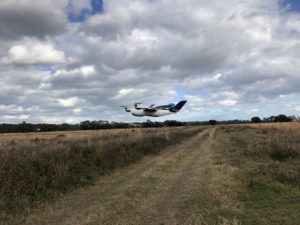
Skyward was a visionary company in commercial drone software: the company was founded in 2012, before the enactment of Part 107. They were acquired by communications giant Verizon in April 2017: since then, parent company Verizon has worked closely with Skyward, utilizing their software and services internally as well as supporting significant efforts to use their communications power to expand the reach of the commercial drone industry. Skyward has been an instrumental partner in projects to expand drone communications, testing applications like drone delivery with parent company Verizon and leading logistics supplier UPS.
These efforts put Skyward in a unique position to help the FAA study cellular connected drones – a tool that could help unlock “complex operations like beyond visual line of sight (BVLOS), universal traffic management (UTM), and one-to-many operations,” says a Skyward press release. Currently, most commercial drones use unlicensed spectrum: restricted in range and subject to interference. “Verizon’s 4G LTE nationwide coverage, provided over spectrum protected from interference, presents an enormous opportunity for drone operations,” says the press release.
Titled “Unmanned Aircraft Systems (UAS)—Cellular Technologies to Support UAS Activities,” the MOA enables Skyward and the FAA to mutually research the capabilities of cellular communication networks for command and control (C2) within the National Airspace System. Partially focused on safety-critical C2 data, the three-year MOA also allows the two groups to propose standards for operations, including BVLOS and over commercial wireless spectrum. Skyward and Verizon will also be using the data and information collected in the course of the MOA to inform its discussions on C2 and BVLOS operations in the FAA’s BVLOS Advisory and Rulemaking Committee.
“Cellular-connected drones play a critical role in enabling tomorrow’s safe, reliable, and secure drone operations,” said Matt Fanelli, Director of Strategy and Operations at Skyward, A Verizon company. “We are thrilled to be laying this foundation with the FAA and are confident that our efforts will help inform technical standards from which industry regulations authorizing low-risk BVLOS and one-to-many operations will flow.”
The MOA is inspired by the previous industry collaborations with the FAA but is intended to address complex UAS operations through joint data collection and analysis. The agreement also follows Skyward’s announced emergency waiver to inspect critical communications infrastructure near the Big Hollow wildfire in Washingtonin September 2020. The industry’s first known fully remote BVLOS operation with no pilot or visual observer on site demonstrated low-risk operation as well as a need for analyzing and sharing fully remote data with standard bodies and the FAA.

Miriam McNabb is the Editor-in-Chief of DRONELIFE and CEO of JobForDrones, a professional drone services marketplace, and a fascinated observer of the emerging drone industry and the regulatory environment for drones. Miriam has penned over 3,000 articles focused on the commercial drone space and is an international speaker and recognized figure in the industry. Miriam has a degree from the University of Chicago and over 20 years of experience in high tech sales and marketing for new technologies.
For drone industry consulting or writing, Email Miriam.
TWITTER:@spaldingbarker
Subscribe to DroneLife here.